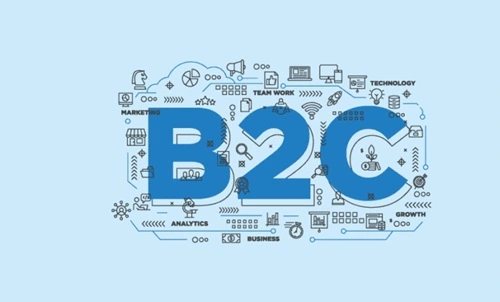Unlike B2B, C2C,D2C or any other type of business model, we don’t even need to explain what a B2C business model is. That’s because it is the simplest and most traditional way of doing business, where a business sells products to a customer directly. Just look around you, and you’ll see a bunch of examples of just that, like that small store around the corner, and there are online players as well such as Amazon, Meta, and even Walmart. But let’s find out whether this business model is any good by taking a good look at some B2C business model advantages and disadvantages. Alright, here we go now.

Advantages of B2C Business Models
1. Reaching Across the Globe
You see, it is not a hidden secret that when you use the internet to start your business, it becomes an international sensation, not just a local thing, you know? This means you can get your goods from store shelves in your area to shopping carts around the world. For example, a digital business can get customers from all over the world, which is something that a real store could never hope to do.
2. Way Lower Operational Costs
Doing business online? Well, if you think of it, this makes perfect business sense. That’s because online businesses save time and money by automating tasks like managing stock and customer chats. You can offer lower prices to customers and make the deal more appealing with this lean setup. This gives your business a clear edge over the competition.
3. Always Open for Business
The bottom line is that B2C companies never say “closed.” Every day and night, during the week and on the weekends, your online store is busy. Because they’re open 24 hours a day, seven days a week, customers can go on shopping sprees at midnight or early in the morning, when most stores are closed. However, that’s only a problem with the local aka physical B2C stores.
4. Speedy Sales Cycles
For B2C, speed is everything. How? No longer do B2B buyers have to wait a long time to make a purchase, B2C buyers move quickly through the stages of buying. Like something on Instagram while you’re eating? You might be able to open the box by dinner. Or just go to a local store and buy your favorite item right away. This short sales cycle keeps the money coming in quickly and steadily.
5. Customer Support? Top-Notch!
What’s more interesting than talking to someone directly? For B2C companies and businesses, this is the golden ticket to get in touch with their customers directly. Because you can talk to them directly, you can change your pitch, make changes to your goods, and get feedback right away. And this is not just an online thing, B2C businesses on the ground level can also provide top-notch customer support.
6. Mastering Data to Know Your Customers
When you’re in B2C, data is always on your side. How? Well, it’s not enough to just keep track of sales, you need to understand behavior, preferences, and trends as well, right? Use this information to improve your stock, change your marketing, and guess what the next big thing will be. Simple as that! Real-time information can help you keep a supply of exactly what your customers want, so your deals always hit the mark.
Disadvantages of B2C Business Models
1. Intense Market Rivalry
Taking a look at the B2C world? Get ready, because it’s a fight. It’s not just tough, there are so many online stores and services all vying for the same customers that it’s almost unbearable. Big companies with lots of money and well-known brands tend to get all the attention, leaving smaller companies behind.
2. Squeezed Profit Margins
In the mad rush to get new customers, many B2C businesses cut prices as a way to stand out. But there’s a catch: as you try to keep your prices low, your profit margins start to shrink. Businesses that sell to other businesses can usually raise their prices, but businesses that sell to consumers have to constantly balance charging low prices with making money. For example, online shops have sales and discounts almost every day, which cuts into their profits.
3. Skyrocketing Marketing Costs
Spending a lot of money on marketing and promoting is normal in the B2C world if you want to not only stay alive but also do well. It’s about staying noticeable and appealing to customers who have a lot of options. This never-ending need to market can waste a lot of money, especially for smaller businesses.
4. Customer Loyalty? Good Luck With That
See, it is very hard to keep people coming back in the business-to-consumer (B2C) world. Customers can quickly change their minds when they have a lot of choices. Because of this, B2C companies have to keep coming up with new ideas to provide great service and deals that customers can’t refuse, you know?
5. Logistical Nightmares
Another major headache is the amount of work that goes into keeping track of inventory, shipping, and returns. It really is super challenging. Simply put, customers are happy when items are delivered on time and can be returned without any problems. As an example, a furniture store that sells things online might only be successful if its shipping and return practices are perfect and not beloved average or even average.
6. Security Risks
In the last few years or so, it has been seen that cybercriminals love going after B2C businesses that are online. Threats like credit card scams and data theft are real and never go away. It’s not a choice to spend money on top-notch cybersecurity steps, it’s necessary. A breach can ruin your image, and you could also get into trouble with the law and lose money.
7. Demand Volatility
If you thought it was hard to guess the weather, try guessing what people will want to buy. Everything from changes in the seasons to the latest business news can send it up and down. Going wrong means either a lot of stuff that hasn’t sold or shelves that are empty.
Conclusion
That’s all for now. See, the B2C business model is one of the traditional ways of doing business, and it is not going anywhere anytime soon. So, if you can deal with the challenges that might occur while you are at it, you’ll be good for the most part diving into it.

